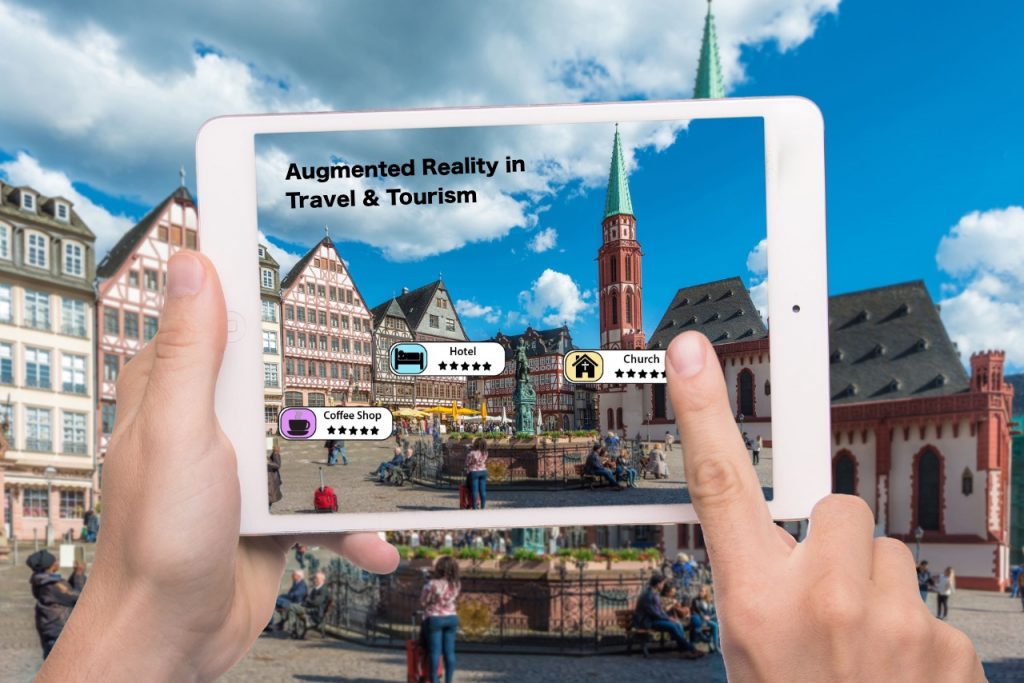Sometimes confused with virtual reality (VR), augmented reality (AR) blends the virtual world with the real world by overlaying computer-generated images onto a user’s actual view. This alters the user’s interactions with his or her environment. It doesn’t completely replace reality with a virtual environment, as is the case with VR but rather augments the experience with non-real elements.
Tourism is vital to many countries’ economies, so it’s no surprise that it’s tapping into AR to enhance the traveler’s experience. There are plenty of possibilities for AR in the travel realm. Here are some of the most important opportunities it presents.
4 Ways Augmented Reality (AR) Can Impact the Travel and Tourism Industry
1. Interactive Maps
Knowing where to go and how to get there is essential to the traveler’s experience. After all, nobody likes being lost in an unfamiliar city, losing precious sightseeing time. Increasingly, tourism-related businesses are turning to software outsourcing companies to facilitate better ways for their consumers to get from point A to point B. Apple Maps, for example, is developing augmented reality (AR) maps that, among other features, will add a navigational layer on top of video footage images that would guide users along their route. Wikitude’s app, meanwhile, points out interesting spots near them, using location-based AR. Users can point their mobile device in the desired direction, and the app will suggest places to visit.
2. Translation
Language can present a barrier when it comes to traveling. Fortunately, through some software outsourcing models and in-house developments, businesses can facilitate better communication. For example, the Google Translate app has an augmented reality (AR) camera that allows users to translate text in realtime by simply pointing their devices at a sign or menu. The user can see the translated text overlaid on the text in the original language through the device.
3. Improved Traveler Experience
The traveler’s overall experience can be enhanced through collaborations with software outsourcing companies as well. For example, some AR apps enable visitors to point their smart devices at objects such as monuments or museum exhibits and learn more about the story and history behind them. Walking tours can become more interactive — visitors can learn more about statues, parks, and so on through apps on their phones. The Smithsonian National Museum of Natural History in Washington D.C. offers AR views of extinct animals whose skeletons are on display in the museum via the Skin and Bones app. This gives visitors a unique insight into how the animals looked, moved, and behaved. Restaurants, meanwhile, can offer interactive menus, providing real views of the meals diners can expect, as well as complete ingredient lists. Given the popularity of scavenger hunt-type games like Pokemon Go, destinations, including theme parks and zoos can leverage AR to offer similar experiences.
3. Marketing and Advertising
Hotels, airlines, and other travel-related businesses are also looking to outsource the development of products integrating augmented reality (AR) for marketing and advertising. Doing so can give prospective consumers a taste of the experience they can expect before they even set foot in their destination. For example, tourists might point their phone at a restaurant and immediately see reviews and discounts to help them decide whether to eat there. Hotels are also equipping their rooms with interactive maps, as described in #1, allowing them to see information about nearby sights and how to get there. This can be a helpful selling point for encouraging visitors to book rooms at the hotel. Augmented reality (AR) is already transforming travel and tourism, attracting visitors through creative marketing tools and campaigns and providing enhanced experiences once they reach their destinations. Businesses in the industry have plenty of opportunities when it comes to this technology, particularly if they outsource development to collaborate on bringing new products to the consumer. The possibilities are endless — in fact, AR could have the power to revolutionize the entire travel industry completely.
